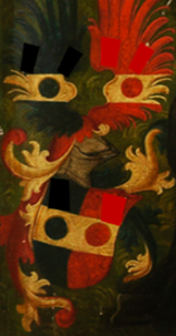
LOCHNER OF NUREMBERG
UPPER CLASS FAMILY WITH IMPERIAL FIEFDOM
In Nuremberg, the old free imperial city, where the electors until today are revolving around emperor
Charles IV in the chimes of the Frauenkirche („women’s church“) on Hauptmarkt („main market“), admired by thousands of tourists, and who – as well – generated the “Golden Bull” in 1356, which marked that election of the king of the Holy Roman Empire of German Nation to be established for all time by the seven electors, another Lochner line will rise in the short term. They are an “honourable family” of the free imperial city, which in their case could have been seen as a kind of “precursor” to the city’s patrician class, because their long-established families are not “afraid” to marry their daughters to the Nuremberg Lochners.
This line apparently descends from the Drossenfeld Lochner’s, they are closely related to the Lochners of Huettenbach and the Bohemian Lochners of Palitz, and move to Nuremberg in the late 14th century. They are referred to as an “upper class family with imperial fiefdom” – and of aristocratic origin (see above detail towards the coat-of-arms of LVN: donor picture of the Lochner-Pirckheimer family “Resurrection of Christ” – today hanging in the Museum for Franconia, Wuerzburg – edited by Katharina Brütting called Lochner). The first Lochner to be mentioned in the registers of Nuremberg (Standbuecher) at those times is in 1378 (“Cunz Lochner”?)
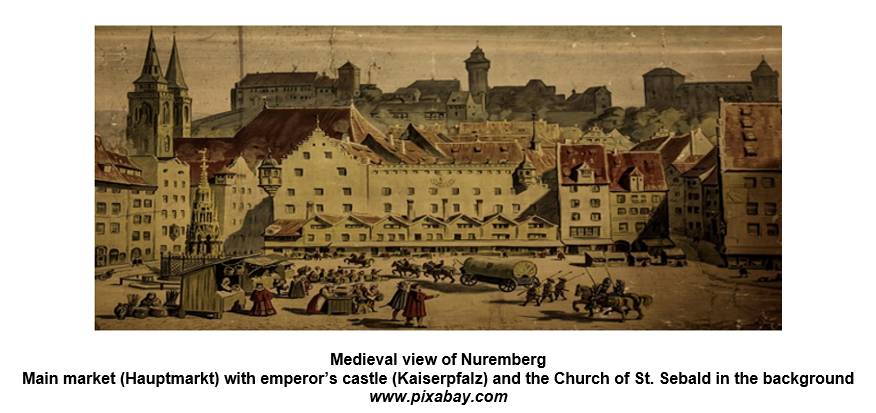
With John I Lochner, a pharmacist, and his wife Christina Holzberger, he has a son of the same name, John II Lochner. This Lochner line commissions two paintings that nowadays are hanging in museums in England and Wuerzburg and are of huge art historical value, and so an authentic image of Lochners have been preserved from the Middle Ages. According to the art historian Anna Moraht, Berlin, „… the inventory of Franconian paintings from the middle of the 15th century is relatively manageable – for this reason alone, the Lochner-Pirckheimer donor painting from around 1465 is a real treasure!“[1]
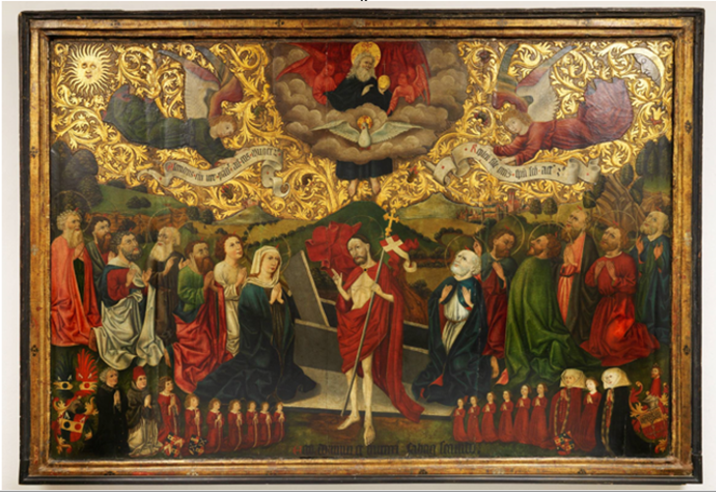

John II Lochner is a respected medical doctor, working both as personal doctor for the House of Hohenzollern and as the city doctor of Nuremberg. In 1435 he went on a long journey of seven months with the sons of the Margrave of Ansbach, John and Albrecht Achilles, to Jerusalem and wrote a detailed, geographically and topographically important report[2]. These travel councils have survived to this day in London, as to have tips for avoiding the omnipresent plague (John II Lochner himself has survived several plague epidemics, such as in Nuremberg in 1437, 1474 and 1483) for his son John III Lochner of Nuremberg, who is a high-ranking clergyman in matters of the free imperial city of Nuremberg at the Vatican in Rome and advisor to Emperor Frederick III, as well as to Duke Sigismund of Tyrol and Margrave Albrecht of Brandenburg[3].
This is particularly underlined by the text of the letter Prof. Dr. Claudia Maertl (Ludwig Maximilian University of Munich) refers to in the introduction of her contribution to the Pirckheimer Yearbook 2003 for Renaissance and Humanism Research (Volume 18) about
“il doctorissimo”, like John III Lochner of Nuremberg is mentioned in Rome, thus on the topic about “Venetian-German cultural relations in the Renaissance”:
“In March 1464, a young man from Nuremberg named Sebastian Lochner came to the court in Mantua of Margravine Barbara Gonzaga, born Hohenzollern. He was on his way to Rome, where he wanted to pick up his brother John Lochner to accompany him back to Germany. To authenticate his identity, Sebastian showed the Margravine a letter from her mother from Bayreuth, in which she praised the father of the brothers in the highest tones: “If we didn’t have him often, we just died a long time ago, but survived with the blessing of God and his abilities”. In fact, the physician Dr. John Lochner – personal physician to the Hohenzollern and Nuremberg’s city doctor – was a widely renowned authority. Barbara Gonzaga adapted her mother’s formulations in her own Italian letter of recommendation, which was addressed to several high-ranking members of the Curia, and added that she felt an obligation to all members of the Lochner family, who had always shown great loyalty to the House of Hohenzollern”[4].
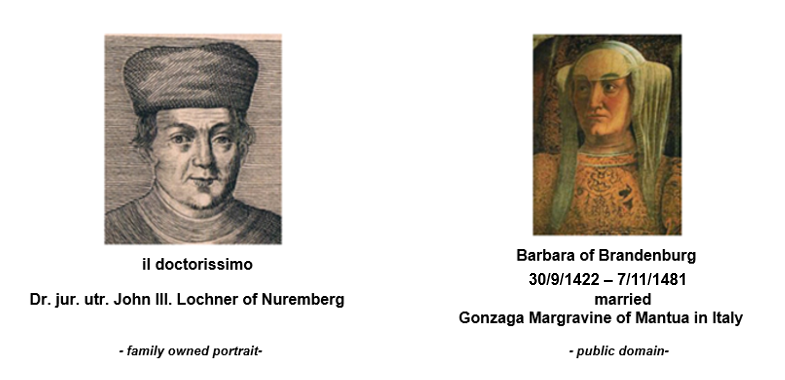
Barbara Gonzaga of Mantua[5], born Hohenzollern (so to say of “early Prussian origin”), maintains active correspondence with John III Lochner, from which it is clear that the two – although there is a huge difference in status – have a relationship that can be described as friendship – more or less [6].
The medical city doctor John II Lochner not only manages to marry into an extremely respected Nuremberg family, but with Clara Pirckheimer, a “great-grandaunt” of Albrecht Duerer’s friend Willibald Pirckheimer and advisor to Emperor Maximilian I, he fathers 16 children, of which just four reach adulthood. The high child mortality rate in the Middle Ages is the main reason why the final rise to the patrician class was impossible. This was certainly considered, as he had ordered his own coat-of-arms variant of the Lochner coat-of-arms created in 1431, in particular the originally silver crossbar is now “gilded” and covered with 2 balls (= or “holes” – Loch-ner in German language has that meaning), the helmet ornament forms an “open flight” instead of the usual buffalo horns[7].

His daughter Clara gives her husband Leonard Pregler four living children, but his surviving next son, Sebastian Lochner (mentioned above) and his wife Martha from the patrician family of the Fuetterer, who are proud owners of a copy of the Augsburg Bible, have no further offspring (twin sons die after a few months and a disabled son named Wolfgang lives in the Augustinian monastery in Neunkirchen a.B. from 1489 on)[8]. The same sad fate befalls the third son Michael II Lochner, according to Germanic National Museum (‘Germanisches Nationalmuseum’), Nuremberg – “Duerer Internet Portal”: he is also a friend of Albrecht Duerer, who, with his wife Catherine of Ploben, has the son Michael III, who dies in young age and the daughter Catherine Lochner of Nuremberg.
Her father, Michael II Lochner, is a rich merchant who is the first to import Venetian glass to Nuremberg and controls the trade route between the two cities. To his only daughter he made a special gift namely two extraordinarily beautiful glass cups for her wedding, which will impress Nuremberg’s patrician class so much that as a result this becomes fashionable among families such as the Imhoff.
Today one of these artistic beakers is to be seen in the Corning Museum of Glass in Corning, New York (the biggest glass museum of the world), and it shows the images of St. Catherine and St. Michael, as well as the coat-of-arms of the family Behaim of Schwarzbach. Their introduction testifies a new aesthetic sensibility among the urban elite of Northern Europe, says Andrea Bayer[9].
Catherine Lochner of Nuremberg celebrates wedding with none other than Michael IV Behaim of Schwarzbach on July 7, 1495:
councilor, mayor and patrician of the free imperial city of Nuremberg. He is the younger brother of the inventor of the world’s first globe, Martin Behaim, which can now be viewed at Germanic National Museum (‘Germanisches Nationalmuseum’), Nuremberg (UNESCO World Heritage Site since 2023), and, as he is a world’s voyager for the kings of Portugal, he often visits them when reaching his hometown.
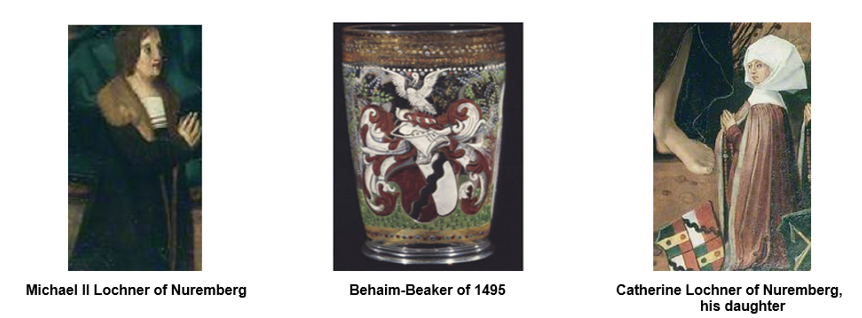

Michael and Catherine remain childless -however, since 1511, they have been raising a nephew from the Behaim clan, who is also called Michael, until he starts his training in Milan in 1523, and who inherits the above-mentioned cups. In addition, in 1511/1512 both of them work as “foundling carers”, i.e. responsible for orphans in the city of Nuremberg.
In 1527, Catharine, Martin Behaim’s sister-in-law, dies and leaves her heritage to the poor (close relatives of this Lochner line are related by marriage to other patrician families (see: 01 LVN PEDIGREE), for example, John Lochner senior in 1470 with Kunigunde Holzschuher, and his children John Lochner junior with Ursula Imhoff, Jobst Lochner with Helene Imhoff and Kunigunde Lochner with Christoph I Harsdoerffer – however, they finally die out with Maria Barbara Margaretha Lochner of Nuremberg at Warmersdorf, born on February 10, 1710 in Nuremberg. She marries John Frederick of Schmidt at Altenstadt in the Margraviate of Bayreuth around 1750)[10].
So Michael and Catherine also commission a painting “Christ taking leave of his mother” (see below), which is attributed to Hans Leonard Schaeufelein from Albrecht Duerer’s circle of 1506 and probably has been hung in the church of St. Sebald in Nuremberg. It can now be seen at Compton Verney Art Gallery, in Warwick, U.K. (near Birmingham), and it shows the alliance crest of the Lochners of Nuremberg and their married families:


E N C L O S U R E:

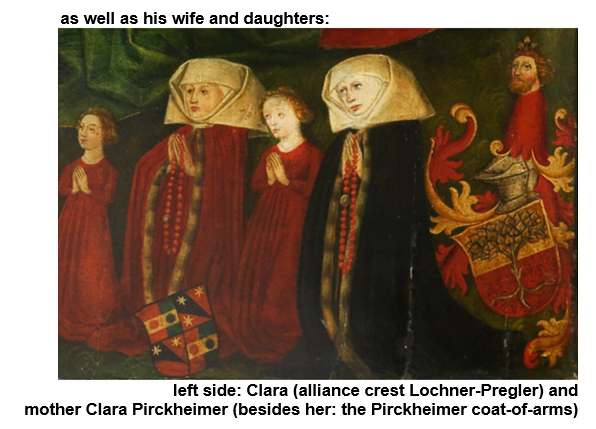
„Resurrection of Christ“ – Donors of this painting is the Lochner-Pirckheimer family, Nuremberg, about 1465 –
in the Museum for Franconia, Wuerzburg, with kind approval of Katharina Nittel, photo by Katja Krause, Wuerzburg –
loaned by “Freunde Mainfränkischer Kunst und Geschichte e.V. Wuerzburg at Museum for Franken, Wuerzburg,
inventory no. A.1145
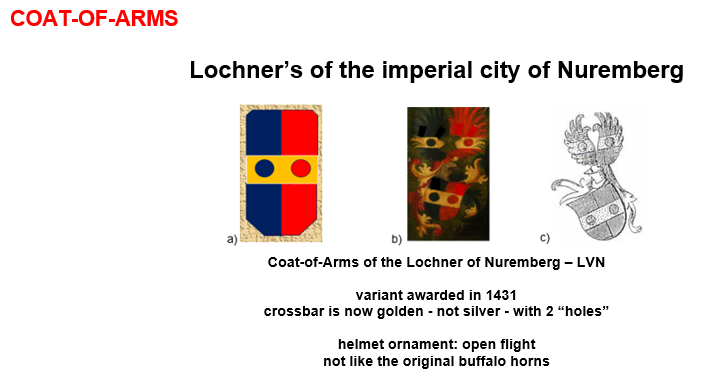
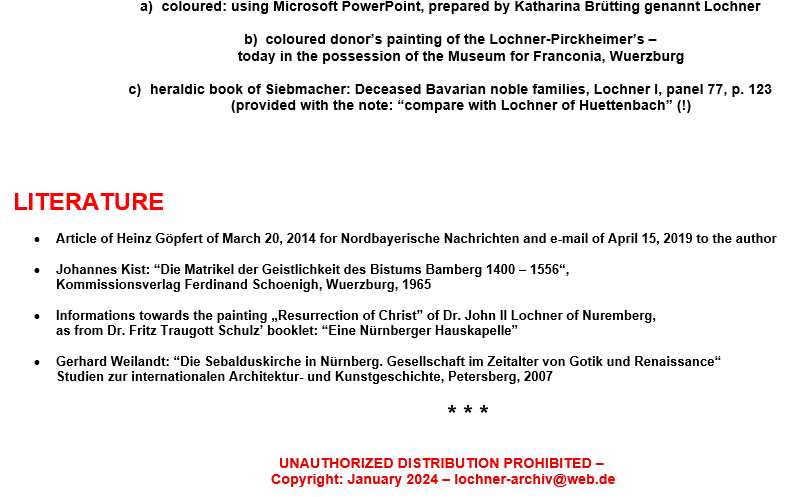
-
Citation according to the email of August 5, 2023 to the authoress ↑
-
Johann Kamann (Editor): „The pilgrimages of Nuremberg citizens to Jerusalem in the 15th century, especially the travel reports of Dr. med. John Lochner and Joerg Pfinzing“, in: MVGN 2 (1880), p. 78 – 163 ↑
-
Wellcome Historical Medical Library – Cod. Wellc. 433 – author: H. J. Vermeer: „John Lochner‘s travel consultations“
in: Sudhoffs Archives for the history of medicine and natural sciences 56 (1972), p. 145 – 196 ↑ -
The letter of Barbara of Brandenburg to her daughter of the same name Barbara Gonzaga is to be found at: Archivio di Stato Mantova, Archivio Gonzaga, Italy, b. 514 fol. 51r of 7th February 1464; the letter of recommendation of Barbara Gonzaga for Sebastian Lochner in ASMnAG b. 2887 l. 43 fol. 87v – 88v of March 14, 1464 ↑
-
Portrait of Barbara Gonzaga Margravine of Mantua in Italy (detail of the fresco by Andrea Mantegna), 15th century ↑
-
Wording of Prof. Dr. Claudia Maertl – from: “Pirckheimer Yearbook 2003 for Renaissance and Humanism Research (Volume 18) about “il doctorissimo”, like John III Lochner of Nuremberg is mentioned in Rome, thus on the topic about “Venetian-German cultural relations in the Renaissance” ↑
-
Coat-of-Arms of the Lochner of Nuremberg at the heraldic book by Siebmacher as „Lochner I – deceased Bavarian nobility II „, panel 77:
awarded by King Sigismund to medical doctor John II Lochner – Sabbato post Ulrici 1431, imperial noble files (Reichsadelsakten) of July 7, 1431, Regesta Imperii XI, No. 8681 – Austrian State Archives, Vienna: AT-OeStA/AVA Adel RAA 253.18 ↑ -
City library of Bamberg StA BA 113 Nr. 4, f. 64/65 and f. 67/68. His father Sebastian Lochner handed over singularly 300 fl in 1489 to the monastery as a socalled
„Leibgeding“ (= pension in old age). ↑
-
Andrea Bayer (Editor): “Art and Love in Renaissance Italy“, Metropolitan Museum of Art, New York, U.S.A. – details concerning these beakers were kindly provided to Mrs. Bayer by Mr. Dedo of Kerssenbrock-Krosigk of the Corning Museum of Glass in Corning, New York State, U.S.A. (today he is head of the German Glass museum Hentrich/Kunstpalast Duesseldorf) – as well as –
Anne Simon: „The Cult of Saint Catherine of Alexandria in Late-Medieval Nuremberg“ – Taylor & Francis Ltd, New Edition 2012 –The 2nd beaker is nowadays privately owned in Bremen. ↑
-
Descendant list of Lorenz Holzschuher of February 2nd, 2016: „Holzschuher – Muffel – Pfinzing“ (No. 986 Cunegunda Lochner, died in 1575, married to No. 1003, Christoph I Harsdoerffer, born 1505 – died in 1573) ↑